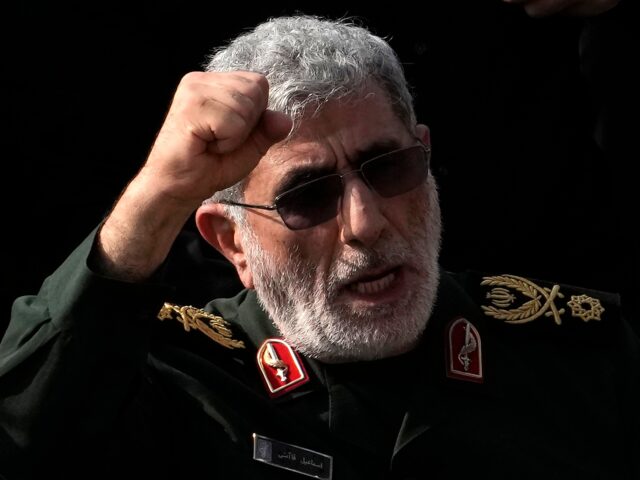Esmail Qaani, the head of the Islamic Revolutionary Guard Corps (IRGC) Quds Force, appeared on Tuesday at the funeral of a fellow senior IRGC commander following weeks of absence that fueled rumors he had fallen out of favor or possibly died.
Qaani has been in charge of the Quds Force since 2020, following President Donald Trump eliminating predecessor Qassem Soleimani in an airstrike in Baghdad. The IRGC is both an official wing of the Iranian military and a U.S.-designated terrorist organization; the Quds Force is its foreign terrorism wing, responsible for strengthening ties with Iranian terror proxies abroad such as Hamas, Hezbollah, Iraqi proxy militias, and the Yemeni Houthi terrorists.
The Quds Force chief had not been seen in public since shortly after an Israeli airstrike in Lebanon eliminated the longtime leader of Hezbollah, Hassan Nasrallah, in early October. Rumors and reports citing anonymous sources suggested Qaani may have been either injured in a related strike or the Iranian regime had turned on him, questioning him about potential security breaches that could have led to Nasrallah’s demise. The Iranian government offered no clear response to the rumors until today, though regime officials had previously insisted Qaani was in good health.
Qaani appeared on Iranian state media and the Islamic Republic News Agency (IRNA) specifically highlighted his presence at Tuesday’s funeral for IRGC Commander Brigadier General Abbas Nilforooshan, noting that he was resurfacing “after rumors spread by anti-Iran media outlets claimed that he had been killed.” IRNA did not reference the reports that Iranian officials had detained Qaani for questioning regarding the Hezbollah strikes.
Qaani, the IRGC-linked Tasnim News Agency reported, “ended speculation about his health by showing up at the Mehrabad Airport of Tehran early Tuesday.” The Quds Force commander was not just present at the funeral, but at a ceremony to receive Nilforooshan’s body from Lebanon. Nilforooshan was eliminated in the same airstrike as Nasrallah, an indication of how closely Hezbollah cooperates with the Iranian state.
Tasnim claimed that the rumors surrounding Qaani’s disappearance where the product of “the Israeli regime’s media” but, in reality, Qaani had in fact not appeared in public for weeks and many of the unverified reports appeared outside of any Israeli media, state or private. The British-based regional outlet Middle East Eye, for example, published one of the first reports suggesting that Qaani had vanished as a result of “suspicions” on the part of Iranian officials who outrank him of a “major security breach in Qaani’s office.” Middle East Eye claimed its sources did not believe Iranian officials suspected Qaani himself of cooperating with Israeli intelligence.
Iran has for years struggled to limit Israeli intelligence operations monitoring its territory, or among its top officials. Former President Mahmoud Ahmadinejad, in an interview in 2021, recalled an incident while he was president in which the regime attempted to build a unit dedicated to countering attempts by Israel to gather intelligence, but “the most senior officer responsible for the control of Israeli spies, responsible for confronting Israeli plots in Iran, himself turned out to be an Israeli agent.”
Middle East Eye also suggested that some rumors had arisen suggesting that Qaani himself had died in an airstrike. Another report by the British outlet Sky News claimed, citing anonymous Iranian sources, that Qaani suffered a heart attack while being questioned on the airstrikes against Hezbollah.
Iran first began addressing the rumors of Qaani’s disappearance a week ago, but only obliquely. The propaganda outlet PressTV claimed that Qaani was “in good health,” without elaborating, and rather than falling into disgrace, was set to receive a medal from “supreme leader” Ayatollah Ali Khamanei “in the coming days.”
Qaani abruptly took over the Quds Force in January 2020 after Soleimani’s death. President Trump ordered an airstrike against Soleimani, a top Iranian government official responsible for hundreds of American casualties, after Iran-backed terrorists in Iraq stormed the U.S. embassy in Baghdad, chanting “death to America” and scribbling “Soleimani is our commander” on the side of the building. The airstrike also eliminated Abu Mahdi al-Muhandis, the founder and leader of the Iraqi Hezbollah Brigades, another Iran-backed terrorist association.
The Iranian regime boasted at the time that Qaani was “one of the prominent commanders during the eight years of Sacred Defense [the Iran-Iraq War] and has been accompanying martyr General Soleimani in the past several years in the region.” In reality, however, experts noted that Soleimani was a singular terrorist talent and Qaani had a reputation for being “uncharismatic” and less experienced, expected to falter particularly with diplomatic duties linking the Quds Force to Iran’s many terrorist proxies around the world. Soleimani’s term was especially successful in bring Iranian terror to the Western Hemisphere, strengthening ties with the socialist regime in Venezuela and enabling firmer relations between Caracas and Hezbollah. The Quds Force has been markedly less active in international terrorism since Soleimani was removed from the battlefield, leaving Iran more reliant of Hamas, Hezbollah, and other terrorist groups.
Follow Frances Martel on Facebook and Twitter.

COMMENTS
Please let us know if you're having issues with commenting.